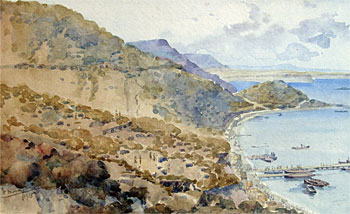Hot bidding for Gallipoli painting Mon, 31 Jul 2006

NEW ZEALAND HERALD 27 JULY 2006
A 1915 painting of Anzac Cove on the Gallipoli Peninsula in Turkey stunned art experts when it sold for nearly five times its estimated value at an art auction in Auckland. The postcard-sized watercolour was painted by Horace Moore-Jones, the artist who made medic John Simpson and his donkey Murphy famous. It was expected to bring $8000 to $12,000 at an auction of New Zealand and European art this week. However, Richard Thomson, from the International Art Centre, said the painting exceeded all expectations when it sold for $55,000. It was bought by a local man who outbid some institutions.
"It was amazing. We got bids from all over the place, including Australia," said Mr Thomson. "I guess it is just the continued interest in that particular subject. It is such an important historic event and anything that captures it is becoming more and more sought after."
Moore-Jones is renowned for his painting of an Anzac medic leading his donkey down the slopes of the Gallipoli Peninsula carrying a wounded soldier in 1915.
The painting was mistakenly named Simpson and His Donkey after John Simpson Kirkpatrick, an Englishman who served as a medic with the Australian Field Ambulance.
However, the work was painted in 1917 from a photo of New Zealand medic Dick Henderson, who served with the New Zealand Field Ambulance and replaced Kirkpatrick when he was killed by a Turkish sniper.
Sapper Moore-Jones survived the war but died in a hotel fire in Hamilton in 1922 as he tried to help people trapped in the building.
Another watercolour by the British master Joseph Mallord William Turner, Plains of Waterloo, sold for $175,000 and broke the record for the most expensive painting sold in New Zealand judged on a square-centimetre basis, Mr Thomson said.
The sale showed an increasing desire to buy art, he said, not only as an investment, but also because "people are into it".
"It is not all about investment. It is not all about money. "It is about people buying their culture back as well."
He said the Moore-Jones painting of Anzac Cove was a classic example.
